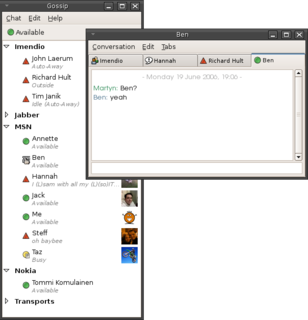Related Research Articles

Instant messaging (IM) technology is a type of online chat allowing real-time text transmission over the Internet or another computer network. Messages are typically transmitted between two or more parties, when each user inputs text and triggers a transmission to the recipient(s), who are all connected on a common network. It differs from email in that conversations over instant messaging happen in real-time. Most modern IM applications use push technology and also add other features such as emojis, file transfer, chatbots, Voice over IP, or video chat capabilities.

In computing, a windowing system is software that manages separately different parts of display screens. It is a type of graphical user interface (GUI) which implements the WIMP paradigm for a user interface.
Universal Plug and Play (UPnP) is a set of networking protocols that permits networked devices, such as personal computers, printers, Internet gateways, Wi-Fi access points and mobile devices to seamlessly discover each other's presence on the network and establish functional network services. UPnP is intended primarily for residential networks without enterprise-class devices.
The Simple Service Discovery Protocol (SSDP) is a network protocol based on the Internet protocol suite for advertisement and discovery of network services and presence information. It accomplishes this without assistance of server-based configuration mechanisms, such as Dynamic Host Configuration Protocol (DHCP) or Domain Name System (DNS), and without special static configuration of a network host. SSDP is the basis of the discovery protocol of Universal Plug and Play (UPnP) and is intended for use in residential or small office environments. It was formally described in an Internet Engineering Task Force (IETF) Internet Draft by Microsoft and Hewlett-Packard in 1999. Although the IETF proposal has since expired, SSDP was incorporated into the UPnP protocol stack, and a description of the final implementation is included in UPnP standards documents.
Transport Layer Security (TLS), the successor of the now-deprecated Secure Sockets Layer (SSL), is a cryptographic protocol designed to provide communications security over a computer network. The protocol is widely used in applications such as email, instant messaging, and voice over IP, but its use in securing HTTPS remains the most publicly visible.

Extensible Messaging and Presence Protocol is an open communication protocol designed for instant messaging (IM), presence information, and contact list maintenance. Based on XML, it enables the near-real-time exchange of structured data between two or more network entities. Designed to be extensible, the protocol offers a multitude of applications beyond traditional IM in the broader realm of message-oriented middleware, including signalling for VoIP, video, file transfer, gaming and other uses.

In computing, Virtual Network Computing (VNC) is a graphical desktop-sharing system that uses the Remote Frame Buffer protocol (RFB) to remotely control another computer. It transmits the keyboard and mouse input from one computer to another, relaying the graphical-screen updates, over a network.

In computing, the Preboot eXecution Environment, PXE specification describes a standardized client–server environment that boots a software assembly, retrieved from a network, on PXE-enabled clients. On the client side it requires only a PXE-capable network interface controller (NIC), and uses a small set of industry-standard network protocols such as DHCP and TFTP.

Google Talk was an instant messaging service that provided both text and voice communication. The instant messaging service was variously referred to colloquially as Gchat, Gtalk, or Gmessage among its users.
Remote administration refers to any method of controlling a computer from a remote location. Software that allows remote administration is becoming increasingly common and is often used when it is difficult or impractical to be physically near a system in order to use it. A remote location may refer to a computer in the next room or one on the other side of the world. It may also refer to both legal and illegal remote administration.

A VoIP phone or IP phone uses voice over IP technologies for placing and transmitting telephone calls over an IP network, such as the Internet. This is in contrast to a standard phone which uses the traditional public switched telephone network (PSTN).
Windows Rally is a set of technologies from Microsoft intended to simplify the setup and maintenance of wired and wireless network-connected devices. They aim to increase reliability and security of connectivity for users who connect the devices to the Internet or to computers running Microsoft Windows. These technologies provide control of network quality of service (QoS) and diagnostics for data sharing, communications, and entertainment. Windows Rally technologies provide provisioning for the following devices:
A smart TV, also known as a connected TV (CTV), is a traditional television set with integrated Internet and interactive Web 2.0 features, which allows users to stream music and videos, browse the internet, and view photos. Smart TVs are a technological convergence of computers, televisions, and digital media players. Besides the traditional functions of television sets provided through traditional broadcasting media, these devices can provide access to over-the-top media services such as streaming television and internet radio, along with home networking access.
Miracast is a standard for wireless connections from sending devices to display receivers, introduced in 2012 by the Wi-Fi Alliance. It can roughly be described as "HDMI over Wi-Fi", replacing the cable from the device to the display.

Chromecast is a line of digital media players developed by Google. The devices, designed as small dongles, can play Internet-streamed audio-visual content on a high-definition television or home audio system. The user controls playback with a mobile device or personal computer through mobile and web apps that support the Google Cast protocol, or by issuing commands via Google Assistant. Alternatively, content can be mirrored from the Google Chrome web browser on a personal computer or from the screen of some Android devices.
Google Cast is a proprietary protocol developed by Google for playing Internet-streamed audio/video content on a compatible consumer device. The protocol is used to initiate and control playback of content on digital media players, high-definition televisions, and home audio systems using a mobile device, personal computer, or smart speaker. The protocol was first launched on July 24, 2013, to support Google's first-generation Chromecast player. The Google Cast SDK was released on February 3, 2014, allowing third parties to modify their software to support the protocol. According to Google, over 20,000 Google Cast-ready apps were available as of May 2015. Support for Google Cast has since been integrated into subsequent devices, such as the Nexus Player and other Android TV devices, as well as soundbars, speakers, and later models of the Chromecast. Consumer devices that natively support the protocol are marketed as Chromecast built-in. As of October 2017, over 55 million Chromecasts and Chromecast built-in devices have been sold.
TVPlayer is an Internet television service in the United Kingdom, owned by international digital distribution company Alchimie. It provides access to free live television channel streams using a web browser or application software via big screen and small screen mobile devices. Alongside the free service, TVPlayer offers multiple no contract monthly subscriptions each carrying different premium live television channel streams.

Foxtel Now is an Australian internet television service which offers subscriptions to over 50 live channels and hundreds of video on-demand titles. The service is owned by Foxtel, and officially launched on 11 August 2013 as Foxtel Play.
Firebase Cloud Messaging (FCM), formerly known as Google Cloud Messaging (GCM), is a cross-platform cloud solution for messages and notifications for Android, iOS, and web applications, which as of 2021 can be used at no cost. Firebase Cloud Messaging allows third-party application developers to send notifications or messages from servers hosted by FCM to users of the platform or end users.
References
- ↑ "The story behind DIAL: How Netflix and YouTube want to take on AirPlay — Tech News and Analysis". Gigaom.com. Retrieved 2014-06-04.
- ↑ Naddaf, Ali (May 1, 2014). "Google Cast Developers (Chromecast developer post)". Google+ .
- ↑ "In the U.S., Tablets are TV Buddies while eReaders Make Great Bedfellows". Archived from the original on 2013-01-22. Retrieved 2014-06-04.
- ↑ "Protocol Specification - DIAL". 2014-05-20. Retrieved 2014-06-04.